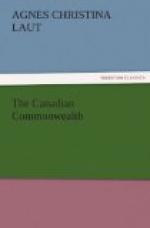Two other comparatively unpondered facts were the hammers that drove the argument for a Hudson Bay route home and forced the Canadian government, irrespective of party, to back the project. The two facts were these—of Canada’s agricultural exports eighty per cent. went to Great Britain. In spite of Canada spending a billion on her transportation system, look at the fact well—it is a poser—only from thirty-two to forty per cent. of her export trade went out by Canadian routing. Why was that? The Department of Railroads and Canals in its annual report explains elaborately that sixty per cent. of Western Canadian grain went out by the Duluth-Buffalo route instead of Ft. William-Montreal because the lake rate of the former was cheaper as three to six cents a bushel; but there is nothing in this argument because Montreal is tidewater. Buffalo is not. To the cheaper Buffalo rate you must add five cents to New York, proving the American routing really two cents a bushel higher. Yet sixty per cent. of Western Canadian wheat went out by the costlier routing. Why? For the same reason that if you jam a bag too full it bursts. Because the Canadian trans-continentals simply could not take care of the traffic blockading tracks and ports and elevators.
So in spite of the funny man’s jokes about a Hudson Bay route being “iron tonic for the cows,” Canada launched on another all-red, to-the-sea railroad project.
IV
What of the road itself?
I camped in the region a few years ago when the venture was still in air. The wheat plains terminate just west of Lake Winnipeg in an interminable swamp region that has been the home of small furs from the beginning of time. Saskatchewan River here literally widens to seventy miles of swamp, where you can barely find foot room dry soled except in winter, when the marsh turns to iron ice twelve feet thick. Through this swamp country runs a ridge of rock northeasterly to Hudson Bay. Down this ridge run Nelson and Hayes and Churchill Rivers in a succession of rapids and lakes, wild rough barren country, where you can paddle in summer or course by dog-train in winter for four hundred miles without sight of arable land or human dwelling. Along this ridge the railroad




